Statement of
Ryan Gallucci, Executive Director
Washington Office
Veterans of Foreign Wars of the United States
Before The
United States Senate
Committee on Veterans’ Affairs
Committee on Armed Services
With Respect To
“Military to Civilian Transition: Ensuring Success After Service”
Washington, D.C.
Chairmen Tester and Reed, Ranking Members Moran and Wicker, and members of the committees, on behalf of the men and women of the Veterans of Foreign Wars of the United States (VFW) and its Auxiliary, thank you for the opportunity to provide our remarks on this vital topic.
We are very grateful to Senators Tester and Moran for their continued push to hold this joint hearing. Nearly 200,000 service members exit the force every year, which is why the VFW believes this should be a regular oversight duty of the Armed Services committee to ensure these troops are not neglected. A solid transition can set veterans up for success after service. Conversely, a failed transition could lead to devastating consequences like unemployment, homelessness, even suicide. The national perception of veterans after service has consequences for the next generation and their propensity to serve. Failed transitions hurt military recruiting efforts. It is long past time that we begin treating transition as a national security priority.
The VFW has an enduring commitment to supporting transitioning service members (TSMs). Often seen on Capitol Hill as an organization solely invested in veterans benefits and related legislation, the VFW is on the ground every day at more than 20 military installations worldwide and interacts with nearly 20,000 TSMs, or approximately ten percent of the total transitioning force, every year. Accredited by the Department of Veterans Affairs (VA), our representatives assist TSMs with Benefits Delivery at Discharge (BDD) claims, provide benefits guidance, and even give VA benefits briefings in Transition Assistance Program (TAP) classrooms. In 2022 alone, our BDD team filed 12,214 claims, ensuring timely connections to veterans’ earned benefits, like VA disability compensation and health care. The VFW’s interactions with and provision of services to TSMs make us an indispensable stakeholder in the military transition space.
In addition to assisting TSMs, our accredited representatives inform VFW legislative efforts around military transition via direct feedback and surveys of TSMs. While much of the feedback we receive is consistent with what is already widely known, such as TAP coursework being akin to getting “hit with a fire hose,” we have been able to identify other specific areas in need of improvement, enhanced oversight, or reform.
BDD Program Access
The VFW highly recommends passage of H.R. 3933/S. 2888, TAP Promotion Act, as we believe there is immense value in ensuring all TSMs can directly access accredited representatives during TAP. This bill would ensure a representative is physically present in the TAP classroom while VA benefits and services that can be applied for prior to separation are discussed, including the BDD program. Currently, Department of Defense (DOD) TAP managers can choose whether to allow representatives into their classrooms, resulting in wide variability with which TSMs are afforded opportunities to directly connect with representatives and begin filing BDD claims. The VFW has strong collaborative relationships with the DOD TAP managers on the installations we currently serve. In places like Fort Cavazos, Camp Pendleton, Joint Base Andrews, and Naval Station Norfolk, we enjoy strong support from TAP managers who understand the value of our programs and services. However, in speaking to program leaders from each service branch, we keenly recognize that these collaborative relationships are the exception and not the rule for 331 total transition sites across the military.
For many, this variability creates unnecessary barriers to participation at a time when personnel are having to balance duty requirements and transition preparation, which are often at odds with each other. Critically, we also see disparity in who is filing BDD claims. Our BDD program users tend to skew toward senior ranks in both the enlisted and officer force, meaning that many are leaving the military with retirement benefits. Accordingly, even without using BDD, they are better positioned to experience less transition unknowns than TSMs in the junior and middle enlisted and junior officer ranks. Alarmingly, these latter cohorts often need more assistance during transition, not less, and include individuals at disproportionately higher risk of suicide–– young, enlisted, male, and exited service within the preceding 12 months.
The VFW finds the above highly concerning, especially considering VA’s recent 2022 National Veteran Suicide Prevention Annual Report that stated veterans who have any contact with the Veterans Benefits Administration (VBA) had a suicide rate of 1.0 per day while those having no interaction with VBA or the Veterans Health Administration had a rate of 6.7. While high level, these data points suggest potential protective qualities may exist for veterans interacting with their earned VA benefits relative to those who have no interaction with VA at large. Combined with passing H.R. 4157/S. 928, Not Just A Number Act, the VFW firmly believes that incorporating accredited representatives in TAP via the TAP Promotion Act can save the lives of veterans, particularly those who are at heightened suicide risk in the initial 12 months after military discharge.
Timeliness
Another critical factor in TSM success after service is participating in DOD TAP early so they can re-engage TAP resources as their post-service plans develop and inevitably change. Timely attendance in TAP classes is critical for TSMs to begin thinking about life as veterans. The vast amount of information covered during TAP is simply overwhelming for many, necessitating extra time to sort through and digest what is pertinent for each person individually. One such example is the BDD program, which is briefly mentioned during the VA Benefits and Services presentation. Any TSM wishing to file a BDD claim must do so between 180 to 90 days before separation or retirement. Accordingly, each member must learn about BDD well in advance of their submission window, ensure medical concerns are documented, and then request their full medical record beforehand, all of which can take weeks to months to complete. It recently took one service member 60 days to obtain their full medical record from Walter Reed, which was received immediately after filing a formal complaint. This particular service member lost the opportunity to file an expedited VA claim because the wait time for records caused the BDD window of time to be missed.
Sadly, many TSMs are not afforded the opportunity to even use the BDD program because they do not get to TAP on time. Another such example is a previous member of Senator Tester’s own staff who recently contacted the VFW to file a BDD claim. There was just one day to spare before no longer being eligible for the program. In a rare stroke of luck, this individual had the necessary medical records on hand to file the BDD claim, and VFW personnel scrambled to help before the hours-long window closed. However, if the deadline had been missed it would have been through no fault of this individual who would have been in good company according to the report on TAP the Government Accountability Office (GAO) most recently published.
The law stipulates that TSMs must begin preseparation counseling no later than 365 days prior to anticipated separation or retirement. Exceptions to this rule will always exist for those who are unexpectedly leaving the military. However, that is why they are the exception and not the rule. Now common knowledge, GAO found that 70 percent of service members did not begin TAP on time, as reported in December 2022. When asked in recent public forums what contributed to poor compliance, DOD stated the COVID-19 pandemic impacted timeliness. Yet, VFW data collected between September 2022 and September 2023—a period which includes nearly five months of survey responses collected after the national COVID-19 emergency ended—suggests more factors hinder timely attendance.
Nearly two-thirds of TSMs we surveyed did not start TAP 365 days before discharge (Figure 1). Of those who started less than 12 months out, almost forty-six percent reported not beginning until six months or less before discharge. In addition to losing essential planning time, service members who complete TAP late are at considerable risk of missing application deadlines, like those for the BDD program and college. Our survey data implies urgent oversight, statutory, and policy improvements are necessary if we want to see change. The deadlines put in place are there for a reason and are not arbitrary dates on a calendar. Troops learning about programs after they miss the deadlines shows the disregard DOD has for the total separating force. DOD is continually failing to make sure troops are set up for success by not requiring adherence to the law.
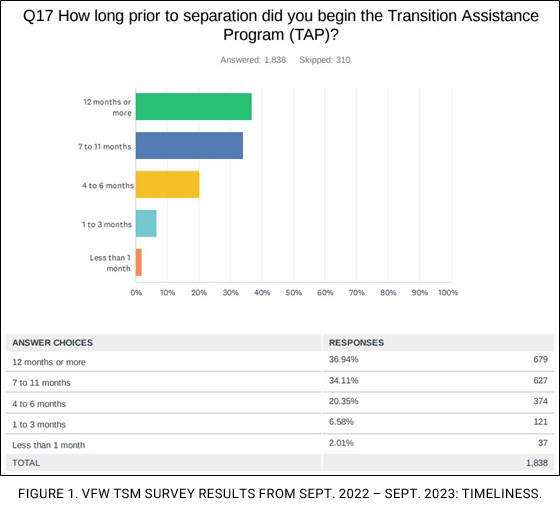
The intent of the fiscal year (FY) 2019 transition law reforms was to ensure TSMs could go to TAP early and often. Specifically, the reforms were intended to ensure TSMs complete the actual TAP course itself including DOD Transition Day, VA Benefits and Services, DOL One-Day, and as applicable a two-day career track at least one year from discharge. While this intent is widely known and DOD officials purport to agree with this intent, in practice it is not adhered to. This is because the law as written leaves room for interpretation and arbitrary application across DOD.
Transition assistance and related timeliness requirements are in 10 U.S.C. § 1142, wherein transition mandates are broadly referred to as “preseparation counseling.” Several points about this statute enable TSMs to miss the deadline of 365 days, again through no fault of their own:
- In practice, preseparation counseling consists of a self-assessment, a one-on-one counseling session, and DD Form 2648, the title of which is “Service Member Pre-Separation/Transition Counseling and Career Readiness Standards Eform.” These requirements largely amount to paperwork, or boxes that TSMs must check, before they physically (or virtually) complete the TAP class, which is where the actual transition assistance takes place. These evolutions represent DOD’s interpretation of what TSMs should complete no later than 365 days from separation or retirement.
- There is no explicit definition of which components of preseparation counseling are to be started 365 days before discharge. This has given DOD the leeway to decide what preseparation counseling looks like and when it is carried out, as described above. Accordingly, if Congress intended preseparation counseling to mean TAP class—as the VFW did during the FY 2019 TAP reform discussions—it appears that DOD has been operating from a different definition that includes paperwork only.
- Also critical, the statute does not say when preseparation counseling shall end by, thereby giving military commanders the latitude to send TSMs to TAP at their personal convenience, not at the necessity of the TSMs in their charge.
- The TAP curriculum itself is not outlined in the law until 10 U.S.C. § 1144. Therein, it states that commanders “may permit a member” to attend TAP before the period established in Section 1142. It does not compel commanders to send them beforehand.
It should also be noted that the same 2022 GAO report found that only eleven percent of TSMs completed preseparation counseling requirements on time. As such, DOD is not even complying with its own interpretation of the law. While the requirements covered under preseparation counseling enable initial planning, they do not cover the “how” of transition, like translating skills to a resume, creating a financial plan, or applying for VA benefits and services.
Considering the factors above, the current DOD TAP policy, DOD Instruction 1332.35, offers conflicting guidance (Figure 2) on when TSMs should begin “transition assistance,” and in no clear terms states when TSMs should go to TAP class itself.
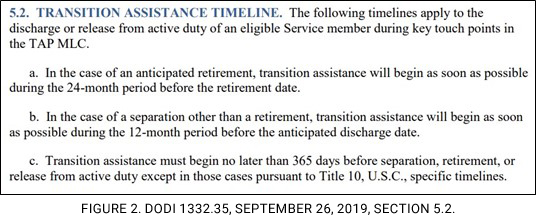
As a result, Army leadership have taken it upon themselves to create their own transition timeline (Figure 3) of when they believe transitioning soldiers should complete TAP components to get what they have stated to be “maximum benefit.” Importantly, TAP class is generally completed in three to five consecutive days. However, according to the Army’s transition timeline, soldiers should complete it over the course of nine months.
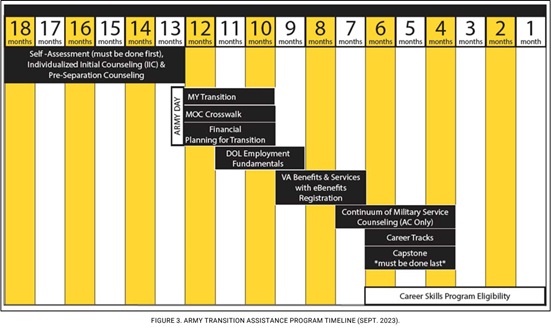
In addition to statutory challenges, other critical factors enable a military transition culture that deprioritizes TSM preparedness and DOD’s compliance with the law. The VFW understands and empathizes with military commanders that operational requirements are paramount. Protecting the nation from foreign and domestic adversaries is the number one charge of DOD, necessitating force availability to carry out missions across domains. This reality is personal and tacit to the VFW. However, getting missions done is all about people—past, present, and future—the full gravity of which we believe is lost on DOD as evidence suggests the Department continues to prioritize operational readiness over TSM long-term success and well-being.
As individuals, we are prone to discounting the future through our choices in favor of short-term gains, even when such choices are not in our long-term best interests. Accordingly, institutions falling prey to this tendency writ large can generally expect long-term outcomes that are contrary to their strategic plans and needs. The VFW contends that much of DOD’s people-related issues, including transition, center on this premise. While it may seem like recruiting and transition are mutually exclusive, they indeed are directly connected. Successful transitions enable the recruiting of subsequent generations by influencing public perceptions of service within communities and across the nation. Veterans holding “homeless veteran” signs speak much louder than successful, well-integrated veterans who do not hold signs proclaiming their success.
Except for those relatively few service members who left the military and subsequently returned, most individuals in leadership roles throughout DOD have never transitioned to civilian life. Leaders in this context span the most junior non-commissioned officers to the most senior generals and admirals. As such, they do not fully understand the gravity of transition for individuals or the military as a whole because they have not personally experienced it and are not taught it. Accordingly, decisions and policies from the lowest to highest levels appear to prioritize transition statute and TSM preparedness largely in name only. This is allowed to persist because TAP law adherence is not measured within DOD in a way that drives accountability, which was among the key takeaways from the May 2023 hearing at which the VFW testified before the House Veterans' Affairs Subcommittee on Economic Opportunity.
Symptoms of absent accountability are illustrated not only in GAO reporting, VFW data, and elsewhere, but also in every instance of service members feeling or actually being limited in any element of TAP as depicted in Figure 4. Service members have even said they felt like they could not focus on transition until they took off their uniforms for the last time. By extension, transition-specific resources like SkillBridge are also negatively impacted by the lack of institutional prioritization of TAP, as evidenced by the Navy’s most recent scaling back of access to the program. While TSMs of all ranks are impacted by DOD’s spotty adherence to the TAP law, the VFW is especially concerned about junior and middle enlisted service members and junior officers who leave the military after one or two contracts, as initially touched on in the BDD section above.
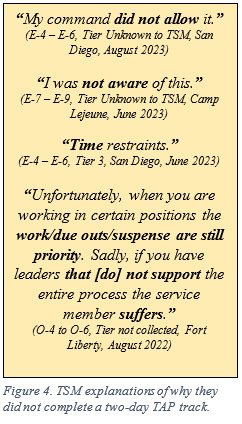
Last month, the DOD Military-Civilian Transition Office held its annual TAP Summit, which was hosted by the Department of Labor (DOL). Included was a panel session with two very recently transitioned senior enlisted personnel. They described their transition experiences and the resources they leveraged to be successful throughout their transition process. When asked whether they could honestly and confidently say E-4s and E-5s are granted the same opportunities and supports they personally received during transition, they both agreed they are not and that they believe the problem spans wider than junior and middle enlisted TSMs.
Both retirees discussed factors that impede equal access across the force, including the fact that junior and middle enlisted TSMs are “tasked with learning their jobs” and have less agency in their work schedules. They also noted that TSMs in general are impacted by leaders’ inconsistent willingness to give them the “space and opportunity” to use transition resources because, as mentioned above, they have not experienced transition themselves and do not “know what’s on the other side.” This leads to a common lack of empathy for and understanding of TSMs’ needs because leaders at all levels are not meaningfully taught about the global implications of transition, including heightened suicide risk. Combined with no real accountability measures, each of these factors coalesce to form a negative climate around transition that essentially penalizes TSMs for exiting the military, leaving many ill-prepared to readjust to civilian life.
The VFW recommends amending Section 1142 (a)(3)(A) of Title 10 U.S.C. to include an end date by which TAP shall be completed no later than. Currently, there is only an open-ended start date with which the services are barely in compliance. DOD must ensure not only starting TAP on time, but also completing it in a timely manner. We also recommend amending Section 1144 (f)(2) of Title 10 U.S.C. from “may permit a member” to “shall permit a member.” Last, we also urge Congress to mandate that DOD begins holding commanders accountable for performance to the TAP law, because what gets measured gets done. Similarly, we recommend DOD integrates training into enlisted and officer leader courses on the implications of transition on individuals and the entire force. A culture shift around transition timeliness and equal resource access cannot happen without accountability and intentional training.
Every service member’s transition and that of their family is different with varying levels of complexity necessitating early receipt of all transition programming, including the full TAP curriculum. Service members facing anticipated separation or retirement must be able to complete all TAP coursework no later than 365 days before discharge from service and be permitted to return as time and unit capacity allows. If we truly seek to ensure service members become successful veterans, thereby acting as community-level ambassadors for military service, they must be afforded every opportunity to properly transition as Congress intended.
Community Connections
Connections to resources in the communities in which service members will reside can be an incredible force multiplier for TSMs and can be the difference between successful transitions and unsuccessful ones. That is why the law was written to ensure these connections are made for all service members leaving the force.
The law as written states “(2) Each member described in subsection (a) shall meet in person or by video conference with a counselor before beginning counseling under this section to—(C) receive information from the counselor regarding resources (including resources regarding military sexual trauma)—(ii) located in the community in which the member will reside after separation, retirement, or discharge.”
This specifies each member is to receive information regarding resources located in the community in which the member will reside after separation. This is not happening for every TSM, and where it is happening it is not being done consistently and effectively. As illustrated in Figure 5, one third of our survey respondents reported they either were not connected to community resources or did not know if they were connected.
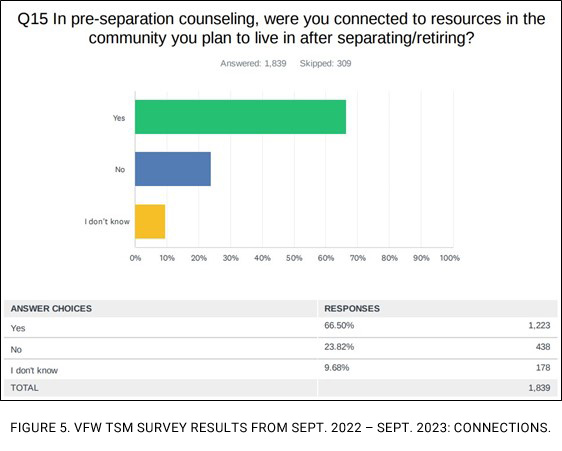
DOD has decided to make “warm handovers” only to agencies for TSMs it determines require the most transition assistance. The law does not state that it is at the discretion of TAP managers to make connections to community resources. It requires those connections be made for all TSMs.
In accordance with this law, we would like Congress to ensure connections are being made consistently between TSMs and resources in the communities to which they are transitioning, with an emphasis on specialized transition service organizations that receive federal grant funding. One existing tool Congress can designate is the National Resource Directory (NRD), which is housed within the Defense Health Agency. NRD, which is a partnership between DOD, VA, and DOL, contains a large repository of strictly vetted organizations that span the transition spectrum from career assistance to caregiver support.
The VFW insists connections to community resources be specifically defined and we recommend that the definition includes NRD. We believe Congress should evaluate and make sure the NRD team and website are properly funded and staffed to accommodate any increased workloads, capabilities, or necessary upgrades.
There are no national transition services in every city and state that support TSMs who are seeking services across all industries. However, there are a multitude of organizations that specialize in certain fields in certain areas of the country. If TSMs are seeking education opportunities, they should be connected to local Student Veterans of America chapters. If they are seeking employment in the technology industry in Texas, they should be connected to organizations like VetsinTech. If they are seeking to enter the finance world in New York City, they should be connected to FourBlock. If they are service members separating from the Special Operations Forces, they should be connected to organizations like The Honor Foundation. Organizations with tailored transition plans for service members and veterans will not be able to offer the most value if they are underutilized and TSMs do not know they exist. TAP cannot be everything for everybody, but there are countless organizations that could offer specialized services as long as DOD makes the connections to community resources as required by law.
Within Section 1142 (c)(2)(C) of Title 10 U.S.C, the VFW recommends that Congress defines “resources” to mean those contained within the NRD. Additionally, we recommend ensuring all service members are connected to community resources as outlined in this section. Currently, DOD is only doing warm handovers to service members who fail readiness standards twice, not the entire force.
Oversight of TAP 6.0
As mentioned above, the VFW had the opportunity to testify before the House Committee on Veterans' Affairs earlier this summer. At the time, we were frustrated by the lack of engagement from certain business lines within VA. We are pleased to report that in the ensuing months the collaboration and communication with VA business lines responsible for TAP have substantially evolved. The VFW is the only organization that participated in multiple pilot programs at Camp Pendleton and Fort Meade. VA invited us to provide feedback on the current TAP 5.1 curriculum. We also participated in a series of summits with VA and DOL on TAP, and recently joined a working session with VA Under Secretary for Benefits Joshua Jacobs, his TAP team, and the Veterans Experience Office where the VFW believes we have built a battle rhythm for consistent updates to the curriculum and collaboration on our shared business processes to help veterans access their earned benefits.
In the lead-up to TAP 6.0, VA has committed to meet consistently with accredited Veterans Service Organizations with a substantial presence on military installations to ensure that the program and the curriculum satisfy the need for TSMs to easily navigate and access their benefits prior to separation. In our latest discussions with VA, we believe that many of the recommendations from the VFW and our peer organizations deeply involved in transition have been accepted for integration into the new curriculum. These improvements include discussing the veteran’s right to competent representation in the VA claims process, comprehensive explanation of VA health care eligibility, and integration of accredited national and state claims representatives into the TAP briefings where available.
The VFW is also working with VA to integrate information on the right to competent, free, and accredited VA claims representation into its military life cycle training. This would ensure that key leaders are well informed on how TSMs under their command should navigate their earned benefits when leaving military service. Tragically, the VFW hears regularly from our accredited advocates and our claims clients that predatory actors have invaded this space, seeking TSMs and veterans to pay exorbitant and illegal fees for VA benefits assistance. To fight this, leaders at all levels of the military should have a keen understanding of how their service members can avoid scams by utilizing properly vetted and accountable resources like VA-accredited claims representatives.
I was just recently approached at a VFW training conference by accredited claims advocate Joseph Zeigler to discuss this problem. Mr. Zeigler provides BDD claims assistance to TSMs on Fort Wainwright in Alaska. He explained that when he meets with service members about their claims they regularly report aggressive solicitations from these predatory companies to sign contracts for VA claims assistance.
Moreover, VFW member Preston Stewart, who is present with the VFW for this hearing, entered into a contract with one of these predatory companies on the advice of peers who are still in uniform. Thankfully, today Mr. Stewart is working with the VFW because not only can we provide a higher level of professional advocacy and service, but we are legally prohibited from stealing his benefits when he receives an award.
In the last year, our dialogue with both VA and DOD has improved, as we have heard both VA Secretary Denis McDonough and Defense Secretary Lloyd Austin tell service members and veterans to never pay for benefits assistance. We have seen numerous consumer warnings from VA leaders and VA’s own inspector general. Our next objective is to ensure that this message resonates with all military leaders so that these predatory companies can no longer scam those who wear the uniform.
We are grateful that VA is building this constructive dialogue, but we must all work together to consistently improve the transition experience and military life cycle for today’s all-volunteer force. Though the VFW is confident that VA is moving in the right direction, we urge the committees to make sure TAP 6.0 is properly reviewed and vetted before full rollout in January 2024.
OBTT for VA Benefits
Finally, another of the VFW’s concerns with military transition is low spouse participation in TAP. Anecdotally, we believe that a spouse often serves as the facilitator of a military family’s transition, managing family affairs while the service member focuses on completing military service obligations. However, spouse participation in transition training is consistently low. While the VFW encourages spouses to participate in TAP, we also recognize that it may not be reasonable to expect more military spouses or family members to attend TAP in its current format during duty hours on military installations.
An alternative solution to this dilemma could be to pilot offering these resources after hours in partnership with community organizations in and around military installations, similar to DOL’s Off-Base Transition Training (OBTT) program. Currently, OBTT offers in-person and online workshops to veteran jobseekers, leaning heavily on state workforce agencies, community service providers, and even VA facilities to offer training and resources. The VFW believes that either integrating VA benefits seminars into the current OBTT program or mirroring the program with a focus on VA benefits offers a pragmatic solution to this problem. We would welcome working with your committees to make this possible.
Considerable progress in improving the transition from military to civilian life has been made since the passage of the VOW to Hire Heroes Act of 2011 (P.L. 112-56). Veteran unemployment is down. Service members are better informed on benefits. Innovative programs like SkillBridge are available to the force. However, those who need these programs and services the most continue to be missed. At a time when the military is worried about recruiting, patriotism among Americans is waning, and our military remains operational around the world, we have a duty to come together to solve these problems and demonstrate the persistent value to serve in the all-volunteer force. The VFW believes that we have a key role to play in this and we welcome dialogue with your committees, VA, DOD, and the service branches to posture our service members to thrive when they remove their uniforms for the last time.
Chairmen Tester and Reed, Ranking Members Moran and Wicker, this concludes my testimony and I welcome any questions you or members of the committees may have.